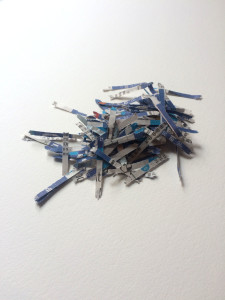I do not do art for sale. I do art because I like it and because I believe it is important for culture. But I am not opposed to selling my works. When somebody decides to buy one of my works, I am very pleased. It is most satisfactory to know that a person wishes to have one of my works for his collection.
Part of the attraction of Feria del Millón in which I participated last October was the possibility of showing my works to a large public, as well as to sell them. At first I approached anyone who stopped for at least two or three seconds in front of any of my works. I told them about the project and the process, and I handed out a text summarizing my ideas. At times I felt like a promoter of any product at a supermarket or shopping center. To some extent, I would have preferred not to be there to “explain” my work, as requested by many of the visitors, and much less to persuade somebody to buy one. But at the same time it was wonderful to be able to talk about my work, to learn and to be enriched by the comments and ideas offered by those I was able to interact with.
Since the opening and throughout the fair I was torn between: (I) it is so good to be able to show and sell my works, and (II) I think what most people want to find is something to decorate their houses and they do not value my art as such. I am pretty sure about the first, but the second is a prejudice or hypothesis that can only be validated through research. Many questions arise: what’s wrong with having one of my works in a living room just because the colors match the couch? Do I have the right to veto a buyer because in my opinion he/she uses valuation criteria that are not purely aesthetic? Is the selection and free use of my work by a collector part of the democratization of art?
I believe that once a piece has been produced and published, it is no longer your own; it belongs to the world, like a child who comes of age or graduates from college and takes his/her own path. I also believe you should be skeptical of the paradigm of the buyer or sophisticated audience who belong to the elite and are the only ones who are sufficiently educated to value and speak about art. I want the images I produce to reach a broad audience: “connoisseurs” or “non-connoisseurs”. And once they are published, they are no longer mine; the receiver activates them and creates new contents, and does not need an “explanation”, though the discourse is also important.
After the fair, I engaged in the process of producing the works that were not exhibited but were purchased for delivery at a later date. In the end, it caught my attention that 90% of my collectors were located in Bogotá. And of these, all of them live in the exclusive neighborhoods of Los Rosales, Santa Ana and Chicó. Another prejudice? Are only the rich interested in art? How can we make art more democratic? Should art seek to be democratic?

